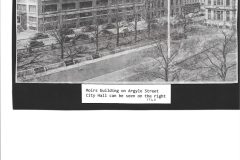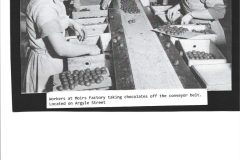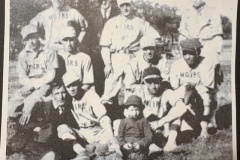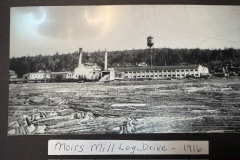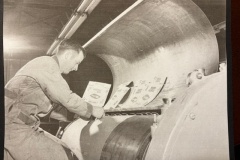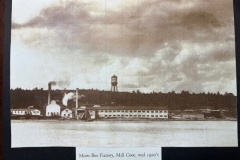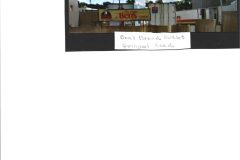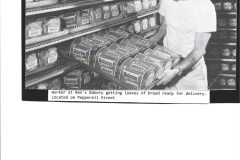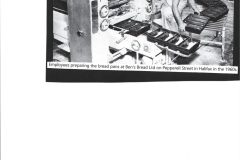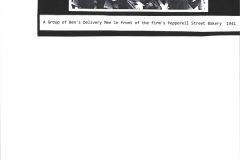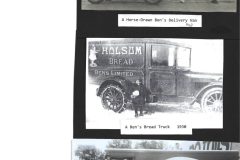Fairview Historical Society Articles Archives
Moirs Chocolate Factory and Ben’s Bread Ltd.
What History! What Legacy! What Happened?
Home – Articles – Videos – eBooks & PDFs – Local Authors – Sponsors – Contact
Submitted by: Devonna Edwards
The business began as a bakery that Alexander Moir, a Scottish emigrant opened on the corner of Duke and Brunswick Streets in the 1790s. He suppled bread to troops at the Fortress on Citadel Hill. By 1815 his son William took over the business and it soon became the town’s largest bakery, making bread for Haligonians as well as for the British troops stationed at the Citadel. In 1862 the bakery expanded to include biscuits and a new five storey building was built on the same site.
In 1873 William’s son James began experimenting with various mixtures of chocolate and candy. James Moir spent long hours in a corner of his father’s bakery trying to perfect various candy recipes. He wanted to produce the finest chocolate in North America. He often sampled his new finds,(sugared almonds, stick candy, peppermint drop) while sitting on Citadel Hill. When he finally took over the family business he was selling his chocolate across Canada and beyond.
In 1891 there was a disastrous fire which destroyed the five storey building, including the bakery, candy machines and the paper box factory. Three hundred people were out of a job, but James was resilient, he rebuilt and began production again. In the early 1900s the company expanded, adding a box making and chocolate facility at Mill Cove in Bedford, today Sobeys grocery store stands on the site. In 1927 a new nine storey building was built on Argyle Street and linked up with the old building. It had 73,000 square feet of total floor area which equals 3/4 acres. The total floor area of the candy factory, including the box factory was about 175,000 square feet, or slightly over 4 acres. It had a large Red Cross Department, lockers and change rooms for 1,250 employees. There were washrooms, toilets and shower baths at the highest grade. The factory occupied a city block, from Argyle Street (main entrance) to Grafton Street and from George Street to Duke Street, with stables, social rooms and store house in the next block. The number of paper boxes manufactured in their plant right on the premises was three million. It was now the largest candy factory in Canada. A large sign with the company’s name “Moirs”, was placed on the top of the building which could be seen brightly glowing at night. Their warehouses were maintained for the storage of nuts, fresh coconut, which was imported from Jamacia twice a month along with other raw materials. Moirs also used strawberries from Nova Scotia and one year made 12,000 pounds of strawberry jam for their famous strawberry centers. In the factory employees could be seen working at conveyor belts filled with candy, adding ingredients to the huge mixing vats of sugar and chocolate. The aroma of the sweet smell of chocolate drifted through the Halifax streets.
During the 1920s James reorganized the business and it continued to thrive. At that time more than 1,000 people were employed there, making chocolates, cakes, bread and biscuits. The staff was mostly women who worked ten hours a day and received twenty-five cents an hour. In 1928 the company’s best-seller, “Pot of Gold” boxed chocolate was presented to the public with great success. Moirs Limited stayed as a family business until 1957, when the company was sold to a group of Maritime businessmen. During the next decade the factory was updated with millions of dollars worth of new equipment. It was the first candy manufacturer to use clear cellophane wrapping to keep its boxed chocolates fresh. Due to the rising cost of ingredients and increased competition Moirs could no longer continue as a locally owned company. In 1967 Moirs candy division was sold to Standard Brands, now Nabisco Brands Ltd. and under the new ownership the Moirs name was retained. In 1975 a new chocolate making factory opened in Dartmouth as part of Hershey Foods Corporation. The new factory in Dartmouth employed 350 workers, who made more than two million boxes of Moirs “Pot of Gold” chocolates, as well as other lines of boxed chocolates each year. In 2007 there were 580 people working at the establishment when they closed and production moved to Mexico, leaving the entire work force unemployed.
The old Moirs building on Argyle Street was demolished in 1975-76 and a new building called the World Trade and Conventional Centre stood in its place. Today the building is the site of Service Canada.
In 1907 James’s brother Ben quit the family business following a disagreement with James, who thought his brother overbearing. Ben Moir prided himself in making the best bread in Halifax, so at the age of forty he started his own bakery and called it “Ben’s Bakery”, located at the corner of Shirley and Walnut Streets.
Ben Moir’s bakery expanded and moved to larger premises (50,000 square foot facility) on Pepperell Street and in 1913 it was called Ben Moir Company Ltd. His brother James whose business was losing bread sales to Ben, disapproved of a rival company using the family surname. Due to this, Ben quickly renamed his bakery Ben’s Limited.
Ben’s business became very successful though the 1920s, cakes, rolls and pies, even baked beans were added to the company’s product line. Ben’s two sons Robert and Ben Jr. both joined the business. In 1926 Ben’s Bakery burned to the ground, but was rebuilt and back in business within four months with new equipment. They then expanded into the canning business, processing more baked bean products, even foxberry jelly, while increasing its line of bakery goods.
Robert Moir died unexpectedly in 1934 and Ben Jr. was left to maintain the business on his own. He was among the first bakers in Canada to install automated pie and doughnut making machines and by 1939 Ben’s bread was the largest selling brand in Nova Scotia.
In 1961 Ben Moir Jr. sold the bakery to Nova Scotia industrialist Roy Jodrey. Ironically, a few years earlier Jodrey purchased Moirs Ltd. the family business Ben Moir Sr. had left a half century before. The two businesses amalgamated and produced bread, doughnuts, cakes, and sweets for the next six years, until in 1967 Jodrey sold the businesses to Standard Brands, now Nabisco Brands. In 2002 Canada Bread acquired Ben’s Bakery and in 2014 Grupo Bimbo, a Mexican corporation bought Canada Bread. They closed the Halifax bakery on Pepperell Street with a loss of 105 jobs, moving the production to New Brunswick and Halifax lost yet another long time business. Today the name “Ben’s Bread is no longer used, it is sold under the label Dempsters, but the bread contains the same ingredients.
In 1928 the Chillicothe Baking Company in Missouri, introduced pre-sliced bread to the public for the very first time.
Otto Rohwedder invented a machine that could not only slice bread, but also wrap it to preserve freshness.
This innovation inspired the phrase, “The Greatest Thing Since Sliced Bread.”
